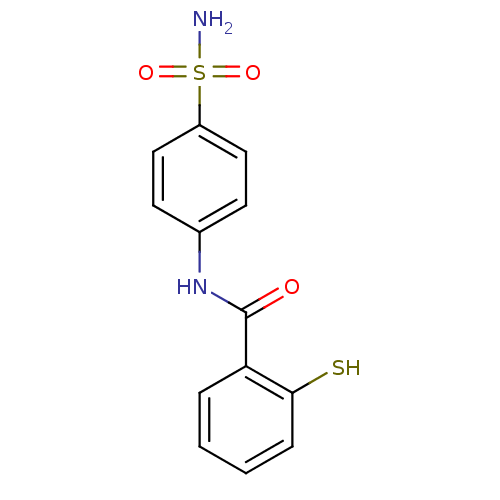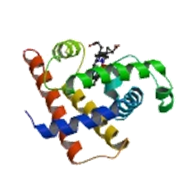BDBM11053 CHEMBL386049::N-(4-sulfamoylphenyl)-2-sulfanylbenzamide::reduced monomeric thio of compound 5a::reduced thio H5a
SMILES NS(=O)(=O)c1ccc(NC(=O)c2ccccc2S)cc1
InChI Key InChIKey=MRLVIVXGUGNENL-UHFFFAOYSA-N
Activity Spreadsheet -- Enzyme Inhibition Constant Data from BindingDB
 Found 10 hits for monomerid = 11053
Found 10 hits for monomerid = 11053
Affinity DataKi: 6.40nMAssay Description:Inhibition of human CA12 by stopped-flow CO2 hydrase assayMore data for this Ligand-Target Pair
Affinity DataKi: 9.10nMAssay Description:Inhibition of human CA9 by stopped-flow CO2 hydrase assayMore data for this Ligand-Target Pair
Affinity DataKi: 9.10nMAssay Description:An Applied Photophysics stopped-flow instrument has been used for assaying the CA-catalyzed CO2 hydration activity. Phenol red has been used as indic...More data for this Ligand-Target Pair
Affinity DataKi: 9.10nMAssay Description:Inhibition of human carbonic anhydrase 9 by stopped flow techniqueMore data for this Ligand-Target Pair
Affinity DataKi: 16nMAssay Description:An Applied Photophysics stopped-flow instrument has been used for assaying the CA-catalyzed CO2 hydration activity. Phenol red has been used as indic...More data for this Ligand-Target Pair
Affinity DataKi: 16nMAssay Description:Inhibition of human carbonic anhydrase 2 by stopped flow techniqueMore data for this Ligand-Target Pair
Affinity DataKi: 79nMAssay Description:Inhibition of human CA5A by stopped-flow CO2 hydrase assayMore data for this Ligand-Target Pair
Affinity DataKi: 114nMAssay Description:Inhibition of human CA5B by stopped-flow CO2 hydrase assayMore data for this Ligand-Target Pair
Affinity DataKi: 276nM ΔG°: -8.85kcal/molepH: 7.5 T: 2°CAssay Description:An Applied Photophysics stopped-flow instrument has been used for assaying the CA-catalyzed CO2 hydration activity. Phenol red has been used as indic...More data for this Ligand-Target Pair
Affinity DataKi: 276nMAssay Description:Inhibition of human carbonic anhydrase 1 by stopped flow techniqueMore data for this Ligand-Target Pair

 3D Structure (crystal)
3D Structure (crystal)